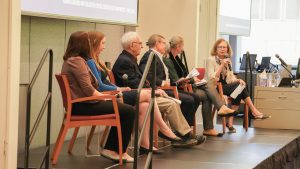Math learning in preschool is often disconnected from math learning in the early elementary grades. This disconnect can lead to students experiencing uneven instructional practices, which can compromise their learning. The goal of the DREME Preschool Through Elementary School Coherence (COHERE) project is to identify policies and practices that are associated with high quality, continuous math education from preschool through the early primary grades. Learn more about the COHERE project.
Advocates for continuity between preschool through third grade often focus primarily on district policies and practices. But many studies have demonstrated that leaders at the school level play a pivotal role in interpreting and applying district policies and practices. [1,2,3,4] Without the wholehearted support from school leaders, district decisions will not likely be effective in promoting high quality and coherent instruction across preschool and the early elementary grades.
Our four-year study of six elementary schools, three each in two large California districts, uncovered specific district strategies that effectively engaged school leaders in improving alignment and continuity in their schools. We call the school districts Cypress and Almond Valley; all six schools in the study served predominantly children from under-resourced neighborhoods. Both districts shared the goal of creating a seamless educational experience for children, where each grade builds on what was learned in the grade before. School leaders in both districts were also committed to creating continuity, but they described their roles in relation to preschool very differently:
- Interviews of principals and other school leaders in the Cypress district revealed low confidence in their ability to provide meaningful instructional support for preschool. They expressed some resentment at having to take on the additional work of preschool, seeing it as a money-saving strategy. Many engaged with preschool mainly around operational issues like compliance paperwork. Principals reported that they lacked knowledge about early childhood education and were not prepared to supervise preschool. Early education coaches provided instructional support to teachers, with very limited involvement from school leadership.
- By contrast, in the Almond Valley district, principals emphasized instruction when asked to describe their role in relation to preschool. They conveyed that their responsibilities in relation to preschool were not different from their responsibilities in relation to the other grade levels. Principals offered instructional support to the preschool classrooms and talked about the need to provide a developmentally appropriate learning environment. They included preschool in their classroom walkthroughs and provided feedback to teachers based on their observations.
Strategies for Alignment and Continuity
What policies and practices might explain why school leaders in the two districts viewed their roles so differently? In our study, we observed three differences in district approaches to creating continuity and to involving school leaders in this process: professional development; instructional oversight; and consistent messaging.
Professional Development
Almond Valley provided intensive professional development that was well attended by school principals. This professional development, created by the district’s Early Education department, consisted of five, 3.5-hour sessions of professional learning. In addition, as part of the training, principals were asked to teach lessons in an early childhood classroom and reflect on their experiences. Principals also had the opportunity to visit early childhood classrooms together, giving them the opportunity to learn from one another’s schools. These practices contributed to school leaders’ knowledge of classroom instruction in the early grades. They also informed district decisions about professional development and other supports for teachers.
Cypress offered few opportunities to principals for professional development in early childhood education. Any formal learning was isolated, a low priority, and not part of an organized effort to position principals as instructional leaders of preschool and the early grades. Few principals participated in the professional development opportunities that were offered, perhaps because some of the assistant superintendents who supervised them did not emphasize the role of school leaders in supporting preschool.
Instructional Oversight
At Almond Valley, principals conducted classroom walkthroughs regularly with their supervising assistant superintendent. The walkthroughs included preschools and were guided by an observation tool that collected data on specific standards. These regular walkthroughs gave district and school leaders an opportunity to observe both instructional quality and coherence in a way that influenced professional development priorities. Leaders also used the data they collected from the walkthroughs to inform policy and practice decisions at the school.
Cypress leaders also conducted classroom walkthroughs with the principals they supervised. However, the walkthroughs were infrequent, did not involve data collection, and rarely included early childhood classrooms. Thus, they did not enable school leaders or district leaders to engage with early childhood classrooms on their sites as part of school improvement efforts.
Coherent Messaging
Almond Valley gave clear and consistent messaging related to the importance of preschool. The district committed to preschool for all students, allocating district resources to ensure that any child who wanted to attend preschool at the district was able to do so. The district also invested in professional development and coaching to prepare school leaders in early childhood education.
Cypress school leaders did not receive clear and consistent messaging about fulfilling an instructional leadership role at their preschools. It is possible that the lack of encouragement and support from district leaders contributed to the way principals viewed their role in relation to preschool as mainly focused on operations and compliance. It could also have detracted some principals from actively seeking opportunities to learn about effective early childhood instruction.
Supporting Principal Leadership for PreK-3
District leaders need to both: a) clearly communicate that school leaders are responsible for the quality of preschool instruction, and b) provide school leaders adequate professional development so they gain a deep understanding of developmentally appropriate and effective preschool instruction. While school leaders in the two districts described their roles in relation to preschool differently, they all commented on the benefits of having preschool programs connected to elementary school. School leaders’ appreciation of preschool signals that, with support from the district, they are well positioned to advance goals for preK-3 alignment.
[1] Coburn, C. (2005). Shaping teacher sensemaking: School leaders and the enactment of reading policy. Educational Policy, 19(3), 476-509.
[2] Seashore Louis, K., & Robinson, V. M. (2012). External mandates and instructional leadership: School leaders as mediating agents. Journal of Educational Administration 50 (5): 629–665.
[3] Shaked, H., & Schechter, C. (2017). School principals as mediating agents in education reforms. School Leadership & Management, 37(1-2), 19-37.
[4] Spillane, J. P., Diamond, J. B., Burch, P., Hallett, T. et al. (2002). Managing in the middle: School leaders and the enactment of accountability policy. Educational Policy, 16(5), 731-762.



